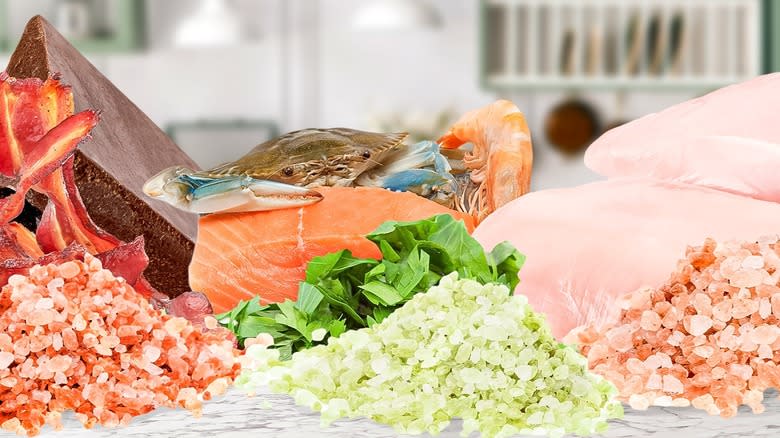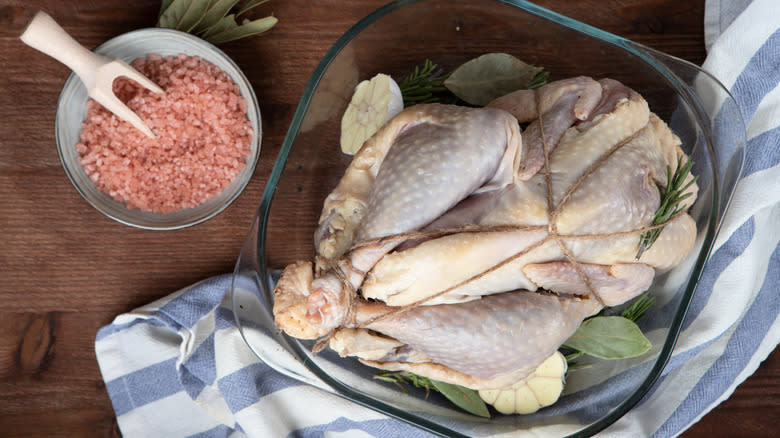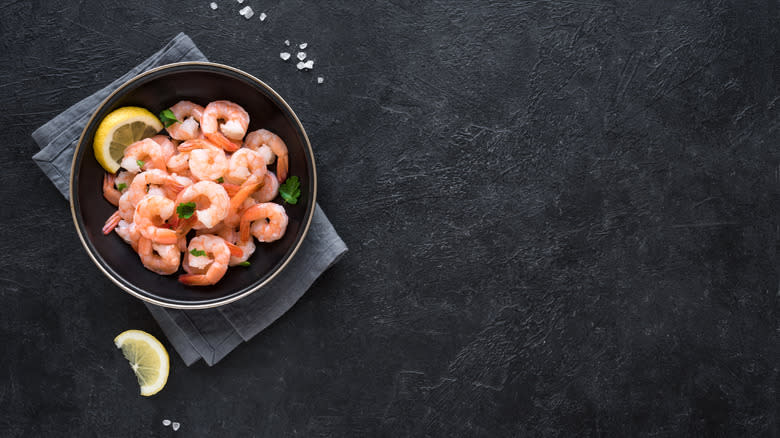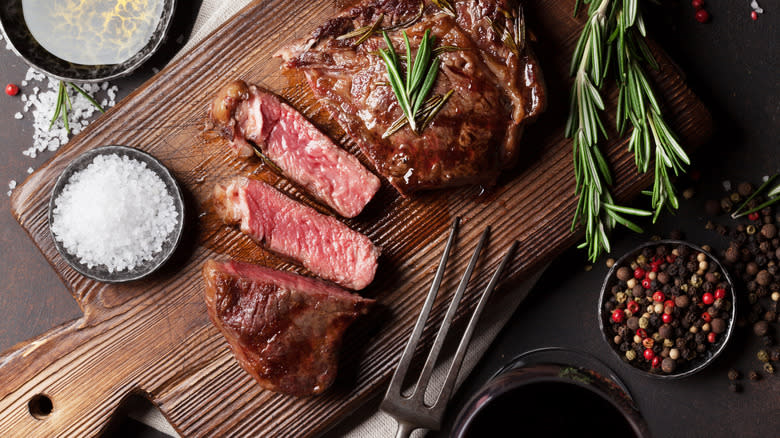The Best Salt Pairings For Different Foods, According To An Expert

No matter what you're cooking -- or what variety of salt you're using -- the mineral is the key to flavorful food. Across the board, salt brings out the taste of almost all ingredients and, with a long-standing history, symbolizes more than just flavor. Yet while salt is a staple across a multitude of dishes, some salts work better than others, depending on the nature of your food. Salt iterations vary in everything from production method to the amount of other minerals added. Some likewise come infused with other flavors, particularly herbs. These salts therefore act as seasonings in addition to salts.
To get a better grasp on food and salt pairing, we spoke with Jerry Tschudy -- the director of food and beverage for Club Med North America. Among other dining destinations, Tschudy oversees Indigo, a restaurant at Club Med's Punta Cana resort, whose menu has a section highlighting the different uses for salt varieties. On its "sea, salt, and fire"-themed menu, it is noted that salts "should be paired, like a fine wine."
While these pairings range, Tschudy pinpoints the specific salts that complement specific foods. Sure, you can add regular table salt to chicken, meat, seafood, and desserts. Yet if you're looking to improve the flavors of your favorite meals, follow Indigo's example and choose your salts carefully.
Read more: Restaurant Foods That Always Taste Better Than What You Make At Home
Pink Himalayan Salt Best Complements Chicken

For chicken, you'll want to grab some pink Himalayan salt, at least according to Tsuchdy and the menu at Indigo. Pink Himalayan salt originates from Pakistan and comes, of course, in a distinctive pink hue. It's a rock salt, so it's slightly bigger than your standard table salt, though it functions more or less the same. When paired with chicken, it carries out the job of seasoning, enhancing taste without overpowering with flavor. It's also widely believed to have health benefits, though this assumption is not scientifically proven.
There's yet another salt, however, that Tschudy pinpoints as a complement to chicken: Parsley salt likewise pairs well with poultry, he said -- though parsley and Himalayan salts may not be as different as they sound. Parsley salt brings a unique, herb flavor to chicken, exactly as its name suggests. However, you can also infuse pink Himalayan salt with parsley to get the best of both options. Many chicken recipes already call for herbs, so parsley salt leans into one of chicken's go-to pairings and offers both a flavoring and a seasoning boost.
Parsley Salt And Citrus Salt Lend Themselves To Seafood

Just as parsley salt complements chicken, it likewise serves a purpose with seafood. Whether you swear by shrimp or tuna, the herbaceous salt ups the ante of your seafood, which often comes with herbs already.
Yet if you're truly looking to add some oomph to the flavors of your fish, you may want to switch gears. In addition to parsley salt, Tschudy recommends citrus salt as an accompaniment to seafood. Citrus salt is a fairly broad category of salt, as it can be made with all kinds of citrus. From lemon salts to lime salts to any salts made with dried citrus, citrus salt is all-encompassing -- and pairs perfectly with foods that could benefit from a burst of acid.
Think about all those times you've squeezed lemon juice onto your fish, and it's easy to understand just why this salt works so well. Simply add some to your grilled fish or shellfish, and you'll brighten the flavor of your food.
Steak Pairs With Red Wine Salt

It's no secret that red meat pairs well with red wine -- so why not incorporate red wine salt into your next steak? After all, it's easy to cook with red wine -- hello, reduction sauces -- so making salt with the signature wine isn't that different.
Specifically, this salt is made by pouring red wine over your salt, straining the mixture, and then baking. Red wine-flavored salt may sound a little far-fetched for seasoning, but the mineral derivative adds color and helps tenderize your meat as a dry rub. It also, of course, adds flavor to your steak.
Of course, if you're not a fan of red wine salt, you can instead try rosemary-infused salt, which Tschudy also recommends for meat. Rosemary and steak are a match made in herb heaven, though if you like both rosemary and red wine, you can combine the two. Your steak will be all the better for it.
What's Sweet Without Salty?

Salted caramel is a classic for a reason. But rather than pair your favorite sweets with standard sea salt, add a bacon-inspired seasoning to the mix. That's right. Bacon and desserts have long been attached to everything from unique ice cream flavors to cupcake mixes. Club Med's Indigo restaurant, however, is proving that the duo is more than a temporary trend. Bacon-flavored desserts are certainly here to stay -- and offer an untraditional, yet delicious, boost to your favorite sweet treats. Bacon has been known to enhance and intensify sweetness. Pair it with salt, and you'll transform your desserts entirely.
Sold on the idea? To add bacon salt to your next dessert, you can easily make your own version by finely chopping bacon with salt. Or, you can buy bacon salt pre-packaged and ready to sprinkle. Whichever option you choose, try the end product over ice cream, cookies, cakes, and the like for added flavor.
Just remember: You don't need a lot of salt to improve your desserts. When used sparingly, salt tends to reduce bitterness, while increasing sweetness. But, when used in high concentrations, it can make your food taste all the more savory. So use just a sprinkle and let the salt surprise you.
Read the original article on Tasting Table.

